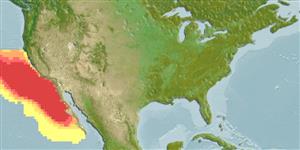>
Lampriformes (Velifers, tube-eyes and ribbonfishes) >
Trachipteridae (Ribbonfishes)
Etymology: Desmodema: Greek, desmos = band, chain + Greek, demos = fat, grease, cow fat (Ref. 45335).
More on authors: Rosenblatt & Butler.
Environment: milieu / climate zone / depth range / distribution range
Ecologia
marino; oceanodromo (Ref. 51243); distribuzione batimetrica 0 - 500 m (Ref. 50610). Subtropical; 40°N - 20°N, 130°W - 109°W
Eastern Central Pacific: off central California, USA to southern Baja California, Mexico.
Size / Peso / Age
Maturity: Lm ? range ? - ? cm
Max length : 114 cm TL maschio/sesso non determinato; (Ref. 2850)
Short description
Chiavi di identificazione | Morfologia | Morfometria
Spine dorsali (totale) : 0; Raggi dorsali molli (totale) : 197; Spine anali: 0; Raggi anali molli: 0; Vertebre: 106 - 111.
Oceanic. Adults are epipelagic to upper mesopelagic (Ref. 36610). Young live near surface. Adults probably occur in deeper water. Oviparous, with planktonic eggs and larvae (Ref. 36610).
Life cycle and mating behavior
Maturities | Riproduzione | Spawnings | Egg(s) | Fecundities | Larve
Eschmeyer, W.N., E.S. Herald and H. Hammann, 1983. A field guide to Pacific coast fishes of North America. Boston (MA, USA): Houghton Mifflin Company. xii+336 p. (Ref. 2850)
IUCN Red List Status (Ref. 130435)
Threat to humans
Harmless
Human uses
Strumenti
Special reports
Download XML
Fonti Internet
Estimates based on models
Preferred temperature (Ref.
123201): 8.6 - 12.9, mean 10.4 °C (based on 15 cells).
Phylogenetic diversity index (Ref.
82804): PD
50 = 0.7510 [Uniqueness, from 0.5 = low to 2.0 = high].
Bayesian length-weight: a=0.00389 (0.00180 - 0.00842), b=3.12 (2.94 - 3.30), in cm total length, based on all LWR estimates for this body shape (Ref.
93245).
Trophic level (Ref.
69278): 4.0 ±0.5 se; based on size and trophs of closest relatives
Resilienza (Ref.
120179): Basso, tempo minimo di raddoppiamento della popolazione 4.5 - 14 anni (Preliminary K or Fecundity.).
Fishing Vulnerability (Ref.
59153): High to very high vulnerability (68 of 100).
